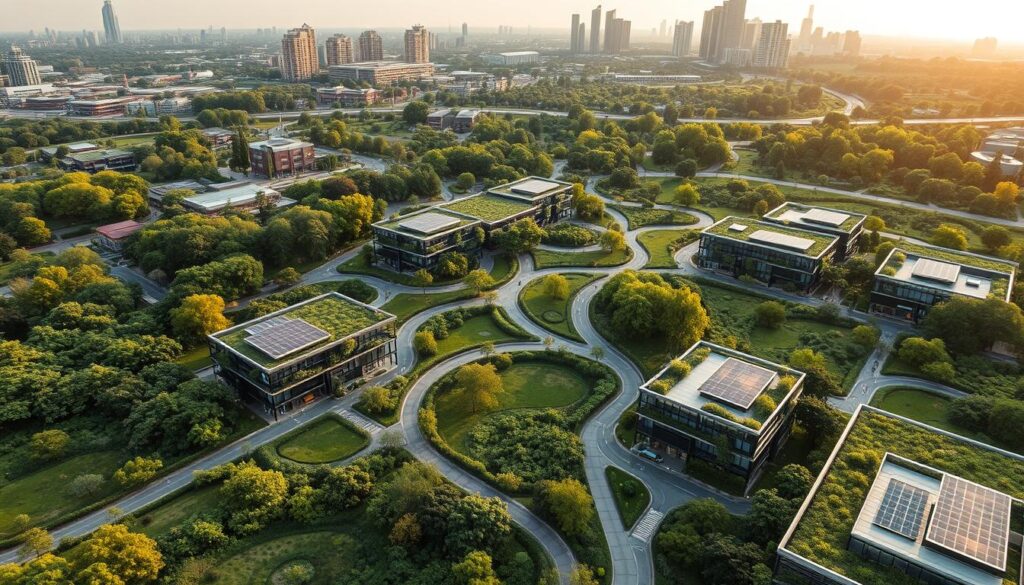As cities around the world continue to grow and urbanize, a pressing question arises: Can incorporating natural systems into urban planning be the key to a more sustainable future?
The importance of green infrastructure developments has become increasingly evident. Green infrastructure refers to the use of natural or semi-natural systems to manage urban environmental challenges.
This includes innovative solutions such as green roofs and walls, as well as community-led initiatives that are transforming urban landscapes.
Key Takeaways
- Understanding the role of green infrastructure in urban planning.
- Exploring the latest developments in green infrastructure.
- Identifying the benefits of incorporating natural systems into urban environments.
- Recognizing the impact of community-led green initiatives.
- Discovering how green infrastructure contributes to more sustainable cities.
Introduction to Green Infrastructure
The concept of green infrastructure has emerged as a critical component in the quest for sustainable urban development. As cities continue to expand, the need for innovative solutions to environmental challenges becomes increasingly pressing.
What is Green Infrastructure?
Green infrastructure encompasses a wide range of practices and systems designed to restore or maintain natural processes in urban environments. This includes parks, green spaces, green roofs, and walls, as well as innovative technologies like rain gardens and permeable pavements.
By incorporating green infrastructure into urban planning, cities can mitigate the impacts of climate change, improve air and water quality, and enhance the overall quality of life for residents. Effective green infrastructure solutions can also contribute to environmental sustainability in urban planning by reducing urban pollution and promoting biodiversity.
“Green infrastructure is not just a nicety, it’s a necessity for creating livable, sustainable cities.” –
Importance of Green Infrastructure for Cities
The importance of green infrastructure for cities cannot be overstated. It plays a crucial role in managing urban environmental challenges, from reducing the urban heat island effect to improving stormwater management.
| Benefits | Description |
|---|---|
| Climate Change Mitigation | Green infrastructure helps cities adapt to climate change by reducing greenhouse gas emissions and mitigating its impacts. |
| Improved Air Quality | By incorporating more green spaces, cities can reduce air pollution, enhancing the health and well-being of residents. |
| Enhanced Quality of Life | Green infrastructure provides recreational spaces, improves mental health, and fosters community engagement. |
In conclusion, green infrastructure is a vital component of modern urban planning, offering numerous benefits that contribute to the sustainability and livability of cities. As urban populations continue to grow, the role of green infrastructure will only continue to expand.
Urban Greening Initiatives
Cities are increasingly adopting urban greening initiatives to combat environmental challenges. These initiatives are crucial for creating sustainable and livable urban environments.
Parks and Green Spaces
Parks and green spaces are fundamental components of urban greening. They provide recreational areas for residents, help mitigate the urban heat island effect, and manage stormwater runoff. Some of the key benefits include:
- Reducing urban temperatures through shading and evapotranspiration
- Improving air quality by filtering pollutants
- Enhancing biodiversity by providing habitats for various species
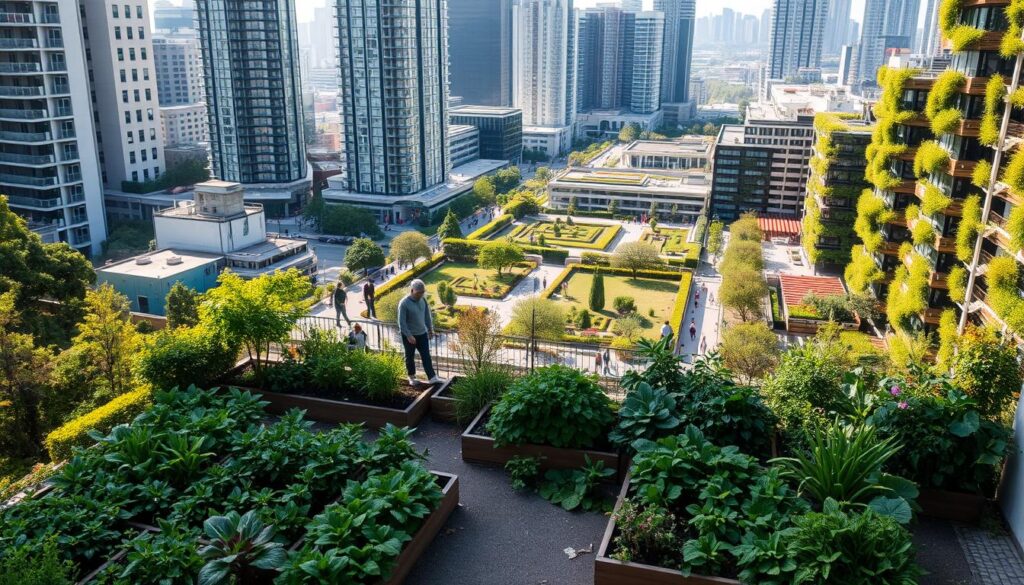
The creation and maintenance of parks and green spaces require careful planning and community engagement. Cities can leverage innovative green infrastructure practices to maximize the benefits of these areas.
Green Roofs and Walls
Green roofs and walls are becoming increasingly popular in urban areas. They not only add aesthetic value to buildings but also provide insulation, reduce energy consumption, and create habitats for wildlife. The benefits of green roofs and walls include:
- Reducing energy consumption through improved insulation
- Creating new habitats for urban wildlife
- Enhancing the aesthetic appeal of buildings
Implementing green roofs and walls requires collaboration between architects, builders, and city planners. By incorporating green infrastructure projects into building design, cities can create more sustainable and resilient environments.
Community Gardens
Community gardens empower local residents to take an active role in urban greening. These gardens foster a sense of community and promote sustainable food systems. The benefits of community gardens include:
- Providing fresh produce to local residents
- Fostering community engagement and social cohesion
- Educating residents about sustainable gardening practices
By supporting community gardens, cities can promote sustainable living and enhance the overall quality of life for their residents.
Sustainable Water Management
Sustainable water management practices are transforming urban landscapes by reducing the environmental impact of stormwater runoff and enhancing water quality. Effective management of water resources is crucial in urban environments where impermeable surfaces can lead to significant water pollution.
Rainwater Harvesting
Rainwater harvesting systems collect and store rainwater for non-potable uses, such as irrigation and toilet flushing, thereby reducing the demand on municipal water supplies. This approach not only conserves water but also decreases the burden on urban drainage systems. The benefits of green infrastructure, like rainwater harvesting, include reduced stormwater runoff and improved water quality.
Permeable Pavements
Permeable pavements allow rainwater to percolate through the surface, reducing runoff and filtering out pollutants. This green infrastructure technology advancement helps to mitigate urban flooding and improve groundwater recharge. By adopting permeable pavements, cities can significantly reduce the environmental impact of urbanization.
Both rainwater harvesting and permeable pavements are integral components of sustainable water management strategies. They not only help in managing stormwater effectively but also contribute to the overall resilience of urban ecosystems.
Climate Resilience Strategies
The escalating impacts of climate change underscore the importance of integrating climate resilience into urban infrastructure. As cities face more frequent and severe weather events, the need for effective strategies to mitigate these impacts becomes increasingly critical.
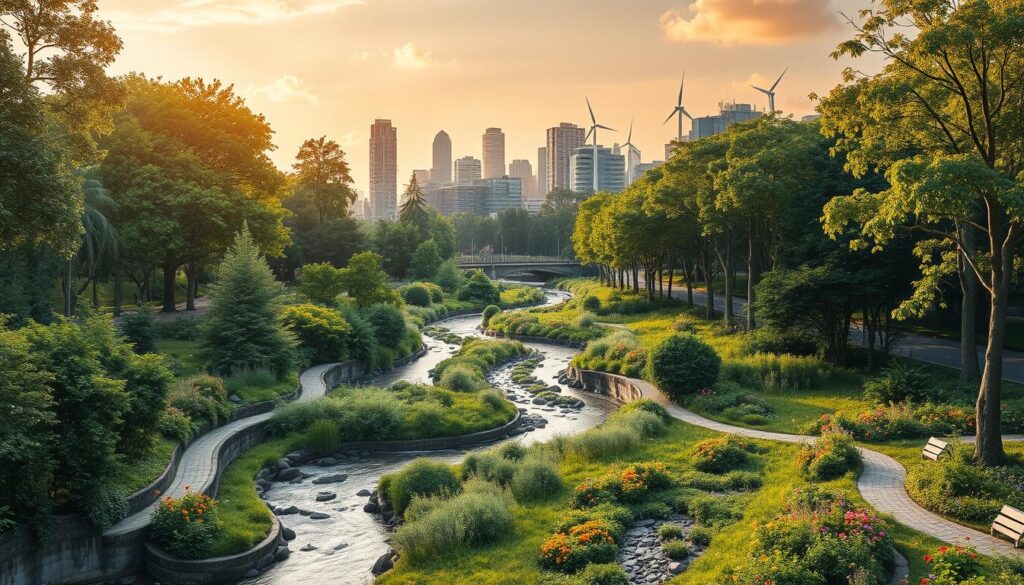
Flood Mitigation Techniques
Flood mitigation is a crucial aspect of climate resilience. Techniques such as wetland restoration and the implementation of green infrastructure help protect communities from flooding. Wetland restoration, for instance, not only provides a natural buffer against floods but also enhances biodiversity and improves water quality.
Other effective flood mitigation strategies include the use of permeable pavements and green roofs. Permeable pavements allow rainwater to percolate through the surface, reducing runoff and alleviating pressure on urban drainage systems. Green roofs, on the other hand, absorb rainwater, reducing the amount of water that enters the drainage system.
“Green infrastructure is not just a nicety, it’s a necessity for cities to survive and thrive in the face of climate change.” –
Heat Island Effect Reduction
The heat island effect is a significant issue in urban areas, where built-up infrastructure and lack of green spaces cause temperatures to be higher than in surrounding rural areas. Strategies to reduce this effect include the implementation of cool roofs and the expansion of green spaces.
- Cool roofs are designed to reflect more sunlight and absorb less heat, reducing the temperature in urban areas.
- Green roofs and walls not only provide insulation but also help to cool the surrounding air through evapotranspiration.
- Increasing green spaces in urban areas helps to mitigate the heat island effect by providing shade and cooling the air.
By incorporating these climate resilience strategies into urban planning, cities can create more sustainable and livable environments. The integration of green infrastructure and innovative technologies plays a vital role in enhancing urban resilience to climate change.
Energy Efficiency Innovations
Energy efficiency is a critical component of modern green infrastructure, driving innovation in urban development. As cities continue to expand, the integration of energy-efficient technologies into green infrastructure is becoming increasingly vital.
Solar-Powered Green Infrastructure
Solar-powered green infrastructure is revolutionizing the way cities approach energy consumption. By harnessing solar energy to power green roofs, urban gardens, and other green infrastructure systems, cities can significantly reduce their reliance on non-renewable energy sources. This not only decreases energy costs but also contributes to a cleaner environment.
Benefits of Solar-Powered Green Infrastructure include reduced energy bills, lower carbon emissions, and enhanced urban sustainability. Cities can also benefit from incentives and tax credits offered for adopting renewable energy technologies.
Smart Grid Integration
Smart grid integration is another key aspect of energy efficiency innovations in green infrastructure. By leveraging advanced technologies such as IoT sensors and data analytics, cities can optimize energy distribution, predict energy demand, and reduce energy waste. This leads to a more efficient energy system that supports the growth of green infrastructure.
Smart grid technologies enable real-time monitoring and management of energy resources, allowing for a more responsive and resilient energy infrastructure. This is crucial for supporting the integration of renewable energy sources and promoting sustainable urban development.
The combination of solar-powered green infrastructure and smart grid integration represents a significant step forward in the pursuit of energy efficiency and sustainability in urban environments. As these technologies continue to evolve, we can expect to see even more innovative green infrastructure practices emerge.
Biodiversity and Ecosystem Support
As cities grow, the role of green infrastructure in maintaining ecological balance becomes increasingly crucial. Green infrastructure developments are not just beneficial for urban residents; they also play a critical role in supporting biodiversity and ecosystem health.
Pollinator-Friendly Landscapes
Creating pollinator-friendly landscapes is a key aspect of green infrastructure. These landscapes help protect and restore pollinator populations, which are essential for food security. By incorporating a variety of plants that provide nectar and pollen, cities can support the health of bees and other pollinators.
Benefits of Pollinator-Friendly Landscapes:
- Enhanced biodiversity
- Improved pollinator health
- Increased food security
According to a study, “Pollinator-friendly habitats can increase crop yields by up to 25% by supporting healthy pollinator populations.”
“The importance of pollinators cannot be overstated. They are crucial for the reproduction of many plant species.” –
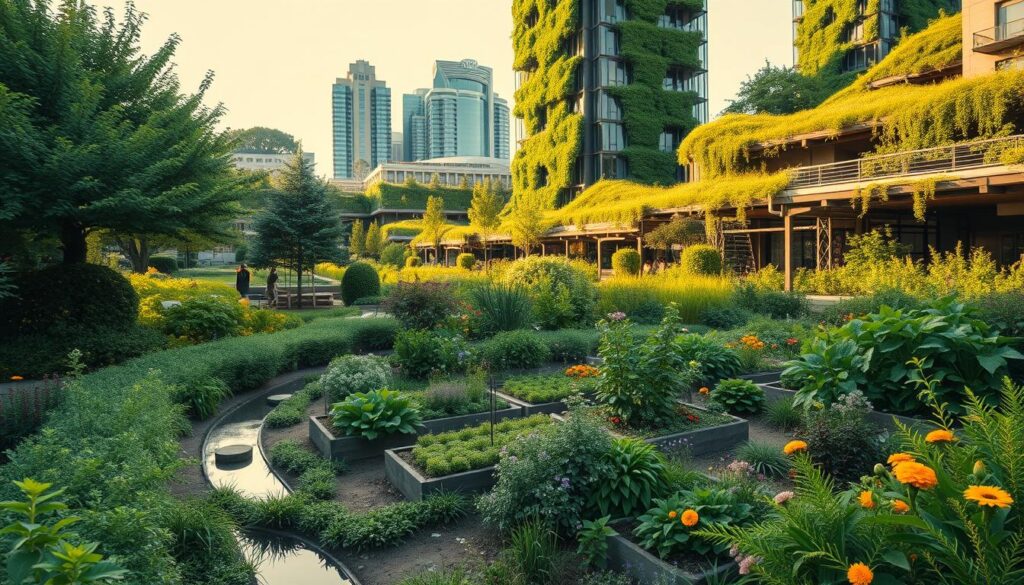
Restoring Natural Habitats
Restoring natural habitats, such as wetlands and forests, is another vital component of green infrastructure. These habitats enhance ecosystem services, including air and water filtration, and provide habitat for a wide range of plant and animal species.
| Ecosystem Service | Benefit | Example |
|---|---|---|
| Air Filtration | Improved air quality | Urban forests |
| Water Filtration | Cleaner water sources | Wetlands |
The benefits of green infrastructure are multifaceted, contributing to both environmental health and human well-being. By investing in green infrastructure developments, cities can reap numerous benefits, from improved biodiversity to enhanced ecosystem services.
Sustainable Transportation Solutions
The future of urban mobility lies in sustainable transportation solutions that prioritize green infrastructure technology advancements. As cities continue to grow, the need for efficient, environmentally friendly transportation systems becomes increasingly critical.
Sustainable transportation is a multifaceted approach that includes various strategies to reduce the environmental impact of moving people and goods within urban areas. Two key components of this approach are bike lanes and walkable cities, as well as electric vehicle infrastructure.
Bike Lanes and Walkable Cities
Creating bike lanes and walkable cities is essential for promoting active transportation. This not only enhances the quality of life for residents by encouraging physical activity but also reduces the reliance on fossil fuels, thereby decreasing air pollution.
Cities that invest in comprehensive bike lane networks and pedestrian-friendly infrastructure see significant benefits, including reduced traffic congestion and improved public health. For instance, cities like Copenhagen and Amsterdam have set exemplary standards with their extensive cycling infrastructure.
Electric Vehicle Infrastructure
The adoption of electric vehicles (EVs) is a crucial step towards sustainable transportation. Supporting this transition requires the development of robust electric vehicle infrastructure, including charging stations that are accessible and convenient for users.
Investing in EV infrastructure not only supports the growth of the electric vehicle market but also contributes to reducing greenhouse gas emissions. Cities and companies are now prioritizing the installation of charging stations, making EVs a more viable option for consumers.
By integrating green infrastructure projects with sustainable transportation solutions, cities can create a more livable, environmentally friendly urban environment. This holistic approach to urban planning is key to addressing the challenges of climate change and promoting sustainable development.
Policy and Regulatory Frameworks
Effective policy frameworks are crucial for the successful implementation of green infrastructure projects. These frameworks provide the necessary guidelines and standards for local and state governments to follow, ensuring that green infrastructure is integrated into urban planning effectively.
Local and State Green Policies are fundamental in setting the stage for green infrastructure development. These policies can include zoning regulations, building codes, and environmental standards that encourage or mandate the incorporation of green infrastructure elements. For instance, cities can adopt policies that require new buildings to include green roofs or walls, or to implement rainwater harvesting systems.
Local and State Green Policies
Local governments play a significant role in shaping green infrastructure through policies that directly impact urban development. For example, the city of Chicago has implemented the Chicago Green Infrastructure Program, which aims to reduce stormwater runoff and improve water quality through the use of green infrastructure. Similarly, states like California have enacted laws that promote sustainable water management practices, including rainwater harvesting and water recycling.
Incentives for Green Infrastructure
Incentives are a powerful tool for encouraging private investment in green infrastructure. Tax credits, grants, and low-interest loans can be offered to developers and businesses that incorporate green infrastructure into their projects. For example, the New York City Green Infrastructure Grant Program provides funding for green infrastructure projects that help manage stormwater runoff and improve water quality.
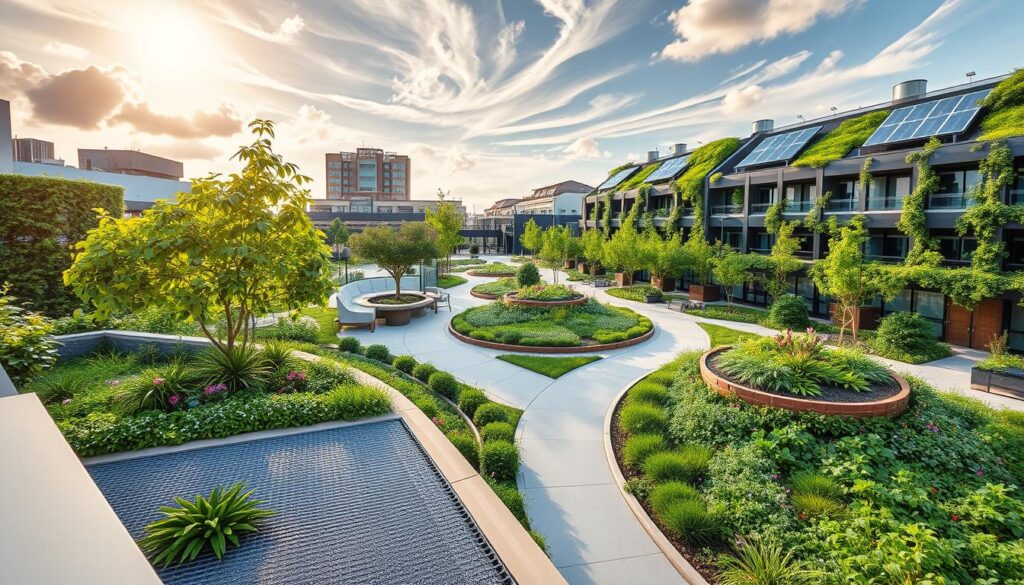
The use of incentives not only drives innovation but also helps to offset the higher upfront costs associated with green infrastructure. By providing financial support, governments can accelerate the adoption of green infrastructure, leading to more sustainable and resilient urban environments.
In conclusion, a well-designed policy and regulatory framework is essential for promoting green infrastructure. By combining effective policies with incentives, governments can create an environment that fosters the growth of green infrastructure, ultimately contributing to more sustainable urban planning and environmental sustainability.
Technology and Green Building Innovations
The integration of technology in green infrastructure is revolutionizing urban sustainability. As cities continue to grow, the need for efficient, sustainable solutions becomes increasingly important. Technology is playing a crucial role in this endeavor, driving innovation and improving the efficiency of green infrastructure systems.
Drones for Monitoring Green Infrastructure
Drones are being increasingly used to monitor green infrastructure, providing valuable insights into the health and performance of green roofs and urban forests. Equipped with advanced sensors and cameras, drones can capture detailed data on vegetation health, growth, and other critical metrics. This information enables city planners and green infrastructure managers to make informed decisions, optimizing maintenance and improving overall sustainability.
For instance, drones can be used to monitor the condition of green roofs, detecting issues such as drainage problems or plant stress. This proactive approach to maintenance can significantly extend the lifespan of green infrastructure and enhance its benefits.
Apps for Community Engagement
Apps for community engagement are another innovative technology being leveraged to promote green infrastructure. These apps enable residents to participate in green infrastructure initiatives, fostering a sense of community and promoting environmental stewardship. By providing a platform for citizens to report issues, suggest improvements, and engage with local green initiatives, these apps help build a more sustainable and responsive urban environment.
“Community engagement is key to the success of green infrastructure projects. By leveraging technology, we can create more inclusive and participatory processes.”
Furthermore, these apps can facilitate education and awareness about the benefits of green infrastructure, encouraging more residents to get involved in local sustainability efforts. As technology continues to evolve, its role in enhancing green infrastructure will only grow, leading to more sustainable, resilient cities.
Case Studies in Successful Green Projects
Trends in green infrastructure are being shaped by successful projects that prioritize sustainability and community engagement. These projects not only enhance environmental sustainability but also improve the quality of life for urban residents.
Several U.S. cities have emerged as leaders in green infrastructure developments, showcasing innovative approaches to urban greening.
Notable U.S. Cities Leading the Way
Cities like Chicago and New York have made significant commitments to green infrastructure. For instance, Chicago’s Green Infrastructure Program has focused on reducing stormwater runoff through the implementation of green roofs and permeable pavements.
“Chicago’s green infrastructure initiative has not only reduced urban flooding but also created new habitats for local wildlife, enhancing biodiversity in the city.”
New York City’s Green Infrastructure Plan aims to manage stormwater runoff while improving water quality. The plan includes the installation of green roofs, rain gardens, and permeable pavements.
| City | Project | Outcome |
|---|---|---|
| Chicago | Green Infrastructure Program | Reduced stormwater runoff, enhanced biodiversity |
| New York | Green Infrastructure Plan | Improved water quality, managed stormwater runoff |
Lessons Learned from Global Examples
Global examples, such as Singapore’s Gardens by the Bay, demonstrate the potential for green infrastructure to transform urban landscapes. These projects offer valuable lessons in sustainability and community engagement.

Singapore’s Gardens by the Bay is a prime example of innovative green infrastructure. The project has not only enhanced the city’s aesthetic appeal but also contributed to its environmental sustainability.
Key takeaways from these global examples include the importance of integrating green spaces into urban planning, engaging communities in green initiatives, and leveraging technology to enhance sustainability.
- Integrate green spaces into urban planning
- Engage communities in green initiatives
- Leverage technology for sustainability
By examining these successful green projects, cities worldwide can gain insights into effective strategies for implementing green infrastructure developments that promote sustainable urban development.
Funding and Investment Trends
Investment in green infrastructure is on the rise, driven by favorable funding trends and technological advancements. As cities continue to grow, the need for sustainable and efficient infrastructure becomes increasingly important.
The role of public-private partnerships is pivotal in driving green infrastructure projects forward. These partnerships leverage private investment to support green initiatives, fostering innovation and improving project delivery efficiency.
Public-Private Partnerships
Public-private partnerships (PPPs) have emerged as a key funding mechanism for green infrastructure. By combining the strengths of both public and private sectors, PPPs can:
- Enhance project financing options
- Improve project management and delivery
- Foster innovation through technology integration
Examples of successful PPPs include green roof initiatives and urban park developments, where private entities collaborate with local governments to create sustainable urban spaces.
Grants and Federal Support
In addition to PPPs, grants and federal support play a crucial role in funding green infrastructure projects. Government grants can provide the necessary capital for projects that may not be viable through private investment alone.
Some of the key benefits of grants and federal support include:
- Enabling cities to implement green infrastructure projects that have long-term benefits
- Supporting research and development in green infrastructure technology
- Encouraging community engagement in green initiatives
By understanding and leveraging these funding and investment trends, cities can accelerate the development of green infrastructure, contributing to a more sustainable future.
Community Involvement and Education
Sustainable urban planning relies heavily on community participation and education. As cities continue to grow and evolve, it’s essential that residents are involved in the decision-making process regarding green infrastructure. This not only fosters a sense of ownership but also promotes environmental stewardship among citizens.
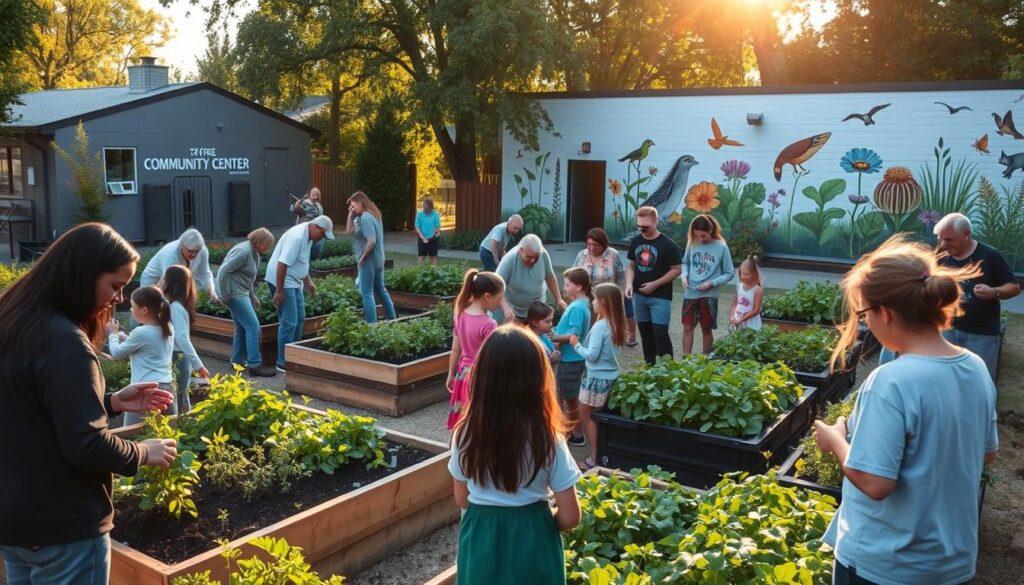
Engaging Citizens in Green Initiatives
Engaging citizens in green initiatives is a multifaceted approach that includes public outreach programs, community events, and participatory budgeting. By involving the community in the planning and implementation phases, cities can ensure that green infrastructure projects meet the needs and expectations of their residents. This can be achieved through:
- Public meetings and workshops
- Online platforms for feedback and suggestions
- Community-led projects and initiatives
Such engagement strategies not only enhance the effectiveness of green infrastructure but also build a stronger, more resilient community.
Educational Programs on Sustainability
Educational programs play a vital role in promoting sustainability and environmental awareness. These programs can range from school curriculums that incorporate environmental education to adult education programs and community workshops. The goal is to equip residents with the knowledge and skills needed to participate in and support green infrastructure initiatives.
Key components of effective educational programs include:
- Practical training on sustainable practices
- Information on the benefits of green infrastructure
- Opportunities for hands-on involvement in green projects
By educating citizens on sustainability, cities can foster a culture of environmental responsibility and promote the long-term success of green infrastructure projects.
The benefits of green infrastructure, such as reduced urban heat island effects and improved air quality, are more likely to be realized when the community is actively engaged and educated on sustainability.
Future Outlook for Green Infrastructure
As cities continue to evolve, the role of green infrastructure in shaping urban sustainability is becoming increasingly important. Emerging trends and technologies are set to revolutionize the way we design and implement green infrastructure, making it more efficient and effective.
Advancements on the Horizon
Advances in materials science and biotechnology are enabling the development of innovative green infrastructure practices. These advancements are expected to drive growth in the green infrastructure market, making it more accessible and widespread.
Trends Shaping the Future
Trends to watch in the next decade include the increasing adoption of green infrastructure in urban planning, the integration of green infrastructure with other urban systems such as transportation and energy, and the growth of green infrastructure markets. As trends in green infrastructure continue to evolve, we can expect to see more sustainable and resilient cities.
